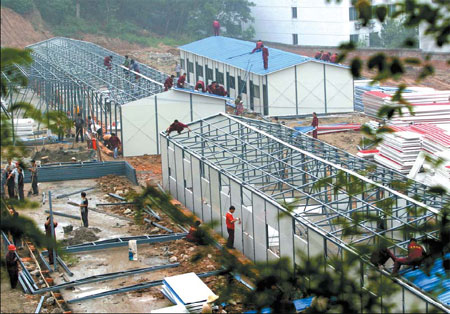|

The 150-km-long urban corridor in Sichuan Province will be expanded to encourage millions of homeless people in the quake-hit regions to move to the urban areas, Yin Qiang, in charge of the province's urban planning reconstruction, said yesterday.
Two new highways will be constructed on the eastern and western sides of the Chengdu-Deyang-Mianyang urban area, which generated about 40 percent of the province's economy before the quake, Yin said.
The central government's urban planning taskforce has suggested the two highways should link the devastated cities of Shifang and Mianzhu from the western side and An'xian and Santan from the eastern side.
"This is part of the plan and the aim is to relocate people from the mountainous regions to the plains, which are more suitable for human habitation," Yin said.
Chengdu-Deyang-Mianyang are already linked by a highway and its width will be expanded by about 40-50 km.
At a seminar on Japan's experiences in post-quake reconstruction held in Beijing yesterday, Koga Shigenari, resident representative of Japan's International Cooperation Agency China Office, said the Japanese government had sent a delegation to Sichuan to identify areas of cooperation.
"Japan has learnt a lot from past quakes and we are eager to share our knowledge with China," Shigenari said.
Yin said the expanded urban scheme was just part of the central government's quake recovery program.
He said teams of experts are expected to submit their first drafts to the cabinet for discussion on July 20.
The reconstruction schemes in Gansu and Shaanxi provinces are also included in the national program. The national program consists of nine sub-programs on matters such as urbanization, rural construction, economic growth, energy, communication and biodiversity.
About 254 towns in eight cities in Sichuan have been severely damaged and must be reconstructed.
Yin said in some of the towns, statisticians have been killed or injured and their office buildings damaged.
"We have encountered great difficulties, but most of all, incomplete statistics," Yin said. "As statistics improve, we will need to readjust our planning."
If they are geologically safe, the towns in the mountainous regions will be rebuilt where they are, Yin said.
The central government has already agreed to relocate Beichuan town.
Yin said Qingchuan town, with more than 30,000 residents, may also be relocated.
"It is no longer a livable place," Yin said. About 300 km from Chengdu, Qingchuan is surrounded by mountains.
However, the Sichuan provincial department of construction said the major problem with Qingchuan is over population.
"At least part of the town is still suitable for human habitation," the deputy department director Li You, said. "We should consider moving some residents out."
(China Daily July 2, 2008) | 